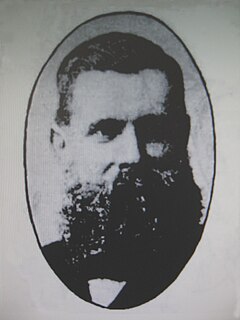
The Independent Commission Against Corruption (ICAC), an independent agency of the Government of New South Wales, is responsible for eliminating and investigating corrupt activities and enhancing the integrity of the public administration in the state of New South Wales, Australia. The Commission was established in 1989, pursuant to the Independent Commission Against Corruption Act, 1988 (NSW), modeled after the ICAC in Hong Kong.

The Supreme Court of New South Wales is the highest state court of the Australian State of New South Wales. It has unlimited jurisdiction within the state in civil matters, and hears the most serious criminal matters. Whilst the Supreme Court is the highest New South Wales court in the Australian court hierarchy, an appeal by special leave can be made to the High Court of Australia.

The District Court of New South Wales is the intermediate court in the judicial hierarchy of the Australian state of New South Wales. It is a trial court and has an appellate jurisdiction. In addition, the Judges of the Court preside over a range of tribunals. In its criminal jurisdiction, the Court may deal with all serious criminal offences except murder, treason and piracy. The Court's civil jurisdiction is generally limited to claims less than A$750,000.
The Compensation Court of New South Wales was a court in the Australian State of New South Wales. It had unlimited jurisdiction within the state in workers compensation matters.
The Land and Valuation Court of New South Wales was a court which had jurisdiction to deal with disputes concerning crown land in New South Wales. It replaced the Land Court of New South Wales on 10 December 1921 and itself replaced by the Land and Environment Court of New South Wales on 1 September 1980.

The Workers Compensation Commission of New South Wales is a tribunal in the Australian State of New South Wales. It has unlimited jurisdiction within the state in workers compensation matters.

The Industrial Relations Commission of New South Wales conciliates and arbitrates industrial disputes, sets conditions of employment and fixes wages and salaries by making industrial awards, approves enterprise agreements and decides claims of unfair dismissal in New South Wales, a state of Australia. The Commission was established with effect from 2 September 1996 pursuant to the Industrial Relations Act, 1996 (NSW).
The New South Wales Coal Compensation Review Tribunal was a tribunal in New South Wales, a state of Australia, which had responsibility for determining appeals about compensation payable when coal in the state was compulsorily acquired during 1981. The tribunal was in operation between 1985 and 1 January 2008.
The Marine Appeal Tribunal of New South Wales, is a former tribunal in New South Wales, a state of Australia, which dealt with appeals from decisions of the NSW Minister for Ports under certain decisions under the Marine Safety Act 1998 (NSW). The tribunal is now constituted under the New South Wales Civil and Administrative Tribunal.
The Court of Coal Mines Regulation was a court established in New South Wales, a state of Australia to investigate mining accidents and to determine certain offences relating to coal mining. The court was abolished on 23 December 2006.
The Coroners Court of Tasmania is the generic name given to the Coronial Division of the Magistrates Court of Tasmania. It is a court which has exclusive jurisdiction over the remains of a person and the power to make findings in respect of the cause of death of a person, a fire or an explosion in Tasmania.
The title of Coroners Court is the name given to proceedings in which a coroner holds an inquest or an inquiry in the Northern Territory.
The Nurses and Midwives Tribunal is a former tribunal that was established in the Australian state of New South Wales which dealt with appeals and complaints of professional misconduct by nurses and midwives. The tribunal generally heard matters after the Nurses and Midwives Board has made a decision or a professional association had referred an issue to the tribunal. The tribunal heard matters in an informal manner in an attempt to do justice in the matter. The tribunal also conducted inquiries into complaints referred by the New South Wales Health Care Complaints Commission.
The Judicial Commission of New South Wales is an independent statutory corporation of the New South Wales Government that provides sentencing information and continuing education to and examines complaints made against judicial officers in New South Wales, Australia.

The Chief Industrial Magistrate's Court of New South Wales, a division of the Local Court of New South Wales, is a court within the Australian court hierarchy established pursuant to the Industrial Relations Act 1996 (NSW).
The Physiotherapists Tribunal is a former tribunal established in the Australian state of New South Wales which dealt with appeals and complaints of professional misconduct by physiotherapists.
The Community Services Appeal Tribunal was an independent tribunal established in the State of New South Wales to deal with breaches of community welfare legislation, as well as handling appeals against licensing decisions in respect of child care services, boarding houses, and foster carers. The tribunal provided the first forum in New South Wales for alternative dispute resolution in New South Wales for resolving disputes. The tribunal replaced the Community Welfare Appeals Tribunal which was known as CWAT.

William Henry John Slee, FGS (1836–1907), was an Australian geologist, mines inspector, and mining warden.

The Threatened Species Conservation Act 1995 was enacted by the Parliament of New South Wales in 1995 to protect threatened species, populations and ecological communities in NSW. In 2016 it was replaced by the Biodiversity Conservation Act 2016. These acts form the basis and the mechanisms in NSW by which species, populations and ecological communities are declared endangered, vulnerable or critically endangered, and under which people and corporations are prosecuted for destruction of habitat sheltering such species, populations or communities. The Act was repealed by the Biodiversity Conservation Act 2016.





